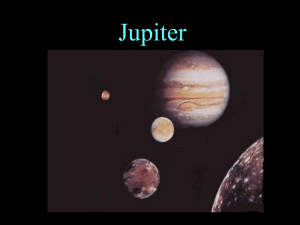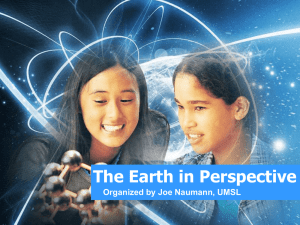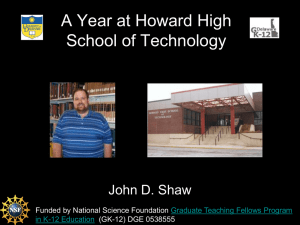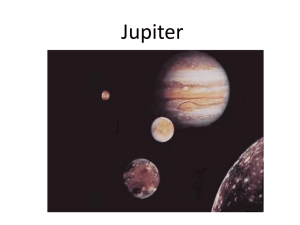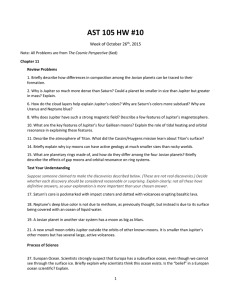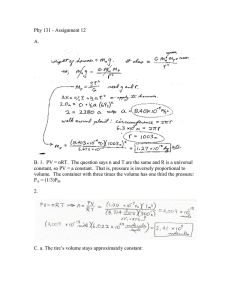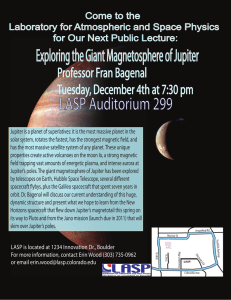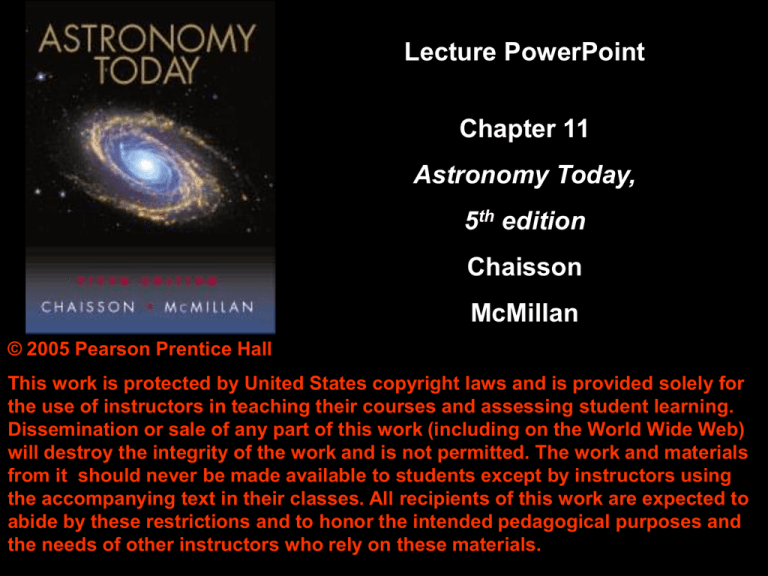
Lecture PowerPoint
Chapter 11
Astronomy Today,
5th edition
Chaisson
McMillan
© 2005 Pearson Prentice Hall
This work is protected by United States copyright laws and is provided solely for
the use of instructors in teaching their courses and assessing student learning.
Dissemination or sale of any part of this work (including on the World Wide Web)
will destroy the integrity of the work and is not permitted. The work and materials
from it should never be made available to students except by instructors using
the accompanying text in their classes. All recipients of this work are expected to
abide by these restrictions and to honor the intended pedagogical purposes and
the needs of other instructors who rely on these materials.
Chapter 11
Jupiter
Units of Chapter 11
Orbital and Physical Properties
The Atmosphere of Jupiter
Internal Structure
Almost a Star?
Jupiter’s Magnetosphere
The Moons of Jupiter
Jupiter’s Many Moons
Jupiter’s Ring
11.1 Orbital and Physical Properties
Jupiter can be imaged well from Earth, even
with a small telescope
Here: Jupiter with its Galilean moons
11.1 Orbital and Physical Properties
• Mass: 1.9 × 1027 kg (twice as much as
all other planets put together)
• Radius: 71,500 km (112 times Earth’s)
• Density: 1300 kg/m3 – cannot be rocky
or metallic as inner planets are
• Rotation rate: problematic, as Jupiter
has no solid surface; different parts of
atmosphere rotate at different rates
• From magnetic field, rotation period is
9 hr, 55 min
11.2 The Atmosphere of Jupiter
Major visible features:
Bands of clouds; Great Red Spot:
11.2 The Atmosphere of Jupiter
Atmosphere has bright zones and dark belts
Zones are cooler, and are higher than belts
Stable flow underlies zones and bands, called
zonal flow
Simplified model:
11.2 The Atmosphere of Jupiter
Real picture is much more complicated.
Here: wind speed
with respect to
internal rotation
rate
11.2 The Atmosphere of Jupiter
Composition of atmosphere: mostly
molecular hydrogen, and helium; small
amounts of methane, ammonia, and water
vapor
These cannot account for color; probably
due to complex chemical interactions
11.2 The Atmosphere of Jupiter
No solid surface; take top
of troposphere to be 0 km
Lowest cloud layer
cannot be seen by optical
telescopes
Measurements by Galileo
probe show high wind
speeds even at great
depth – probably due to
heating from planet, not
from Sun
11.2 The Atmosphere of Jupiter
Great Red Spot has existed for at least 300
years, possibly much longer
Color and energy source still not understood
11.2 The Atmosphere of Jupiter
Lightning-like flashes
have been seen; also
shorter-lived rotating
storms
One example: Brown
Oval, really a large
gap in clouds
11.3 Internal Structure
Find that Jupiter radiates more energy than it
receives from the Sun:
• Core is still cooling off from heating during
gravitational compression
Could Jupiter have been a star?
• No; it is far too cool and too small for that. It
would need to be about 80 times more massive
to be even a very faint star
11.3 Internal Structure
No direct information is available about Jupiter’s interior,
but its main components, hydrogen and helium, are quite
well understood. The central portion is a rocky core.
11.4 Jupiter’s Magnetosphere
Jupiter is surrounded by belts of charged particles,
much like the Van Allen belts but vastly larger
Magnetosphere is 30 million km across:
11.4 Jupiter’s Magnetosphere
Intrinsic field strength
is 20,000 times that of
Earth
Magnetosphere can
extend beyond the
orbit of Saturn:
11.5 The Moons of Jupiter
61 moons have now been found orbiting
Jupiter, but most are very small.
The four largest are the Galilean moons, so
called because they were first observed by
Galileo:
• Io, Europa, Ganymede, Callisto
Galilean moons have similarities to terrestrial
planets; orbits have low eccentricity, largest is
somewhat larger than Mercury, and density
decreases as distance from Jupiter increases
11.5 The Moons of Jupiter
The Galilean moons:
11.5 The Moons of Jupiter
And their interiors:
11.5 The Moons of Jupiter
Small moons: mostly eccentric orbits far from Jupiter.
Here, the orbits of the Galilean moons can be seen in
the center:
11.5 The Moons of Jupiter: Io
Io is the densest of Jupiter’s moons, and the
most geologically active object in the solar
system
• Many active volcanoes, some quite large
• Can change surface features in a few weeks
• No craters; they fill in too fast – Io has the
youngest surface of any solar system object
11.5 The Moons of Jupiter: Io
Orange color is probably from sulfur
compounds in the ejecta
11.5 The Moons of Jupiter: Io
Cause of
volcanism:
Gravity!
Io is very close to
Jupiter, and also
experiences
gravitational forces
from Europa. The
tidal forces are
huge, and provide
the energy for the
volcanoes.
11.5 The Moons of Jupiter: Io
Volcanic eruptions also eject charged particles;
these interact with Jupiter’s magnetosphere and
form a plasma torus:
11.5 The Moons of Jupiter: Europa
Europa has no craters; surface is
water ice, possibly with liquid water
below
Tidal forces stress and crack ice;
water flows, keeping surface relatively
flat
11.5 The Moons of Jupiter: Europa
Resulting ice jumble can be complex:
11.5 The Moons of Jupiter:
Ganymede and Callisto
Ganymede is the largest moon in the solar
system – larger than Pluto and Mercury
History similar to Earth’s Moon, but water ice
instead of lunar rock
11.5 The Moons of Jupiter:
Ganymede and Callisto
However, areas once thought to be flat turn
out to have structure; may be due to a form of
plate tectonics
11.5 The Moons of Jupiter:
Ganymede and Callisto
Callisto is similar to Ganymede; no evidence of
plate activity
11.6 Jupiter’s Ring
Jupiter has been found to have a small, thin ring:
Summary of Chapter 11
• Jupiter is the largest planet in the solar
system
• Rotates rapidly
• Cloud cover has three main layers, forms
zone and band pattern
• Great Red Spot is a very stable storm
• Pressure and density of atmosphere increase
with depth; atmosphere becomes liquid and
then “metallic”
Summary of Chapter 11, cont.
• Relatively small rocky core (but still about
10x size of Earth)
• Still radiating energy from original formation
• 61 moons, four very large
• Io: active volcanoes, due to tidal forces
• Europa: cracked, icy surface; may be liquid
water underneath
• Ganymede and Callisto: similar; rock and
ice

